Related Research Articles

A water wheel is a machine for converting the energy of flowing or falling water into useful forms of power, often in a watermill. A water wheel consists of a wheel, with a number of blades or buckets arranged on the outside rim forming the driving car. Water wheels were still in commercial use well into the 20th century but they are no longer in common use. Uses included milling flour in gristmills, grinding wood into pulp for papermaking, hammering wrought iron, machining, ore crushing and pounding fibre for use in the manufacture of cloth.
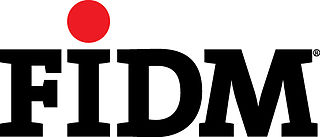
The Fashion Institute of Design & Merchandising (FIDM) is a private college in downtown Los Angeles.
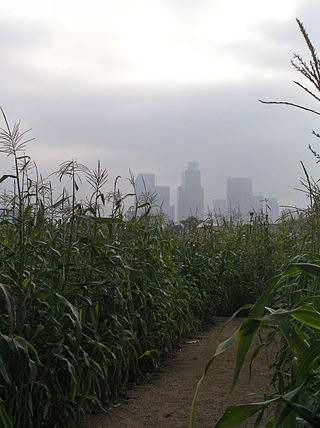
"Not A Cornfield" was a 2005 art project that transformed a 32-acre (130,000 m2) industrial brownfield into a cornfield for one agricultural cycle. The project took place north of Chinatown.
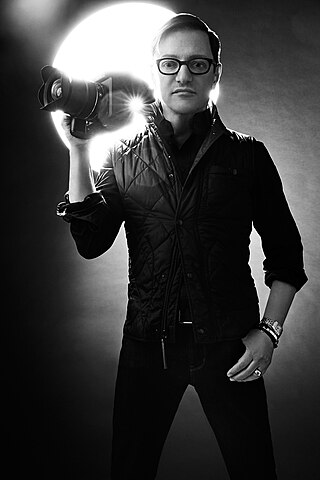
Matthew Russell Rolston is an American artist, photographer, director and creative director, known for his lighting techniques and detailed approach to art direction and design. Rolston has been identified throughout his career with the revival and modern expression of Hollywood glamour.

Millard Owen Sheets was an American artist, teacher, and architectural designer. He was one of the earliest of the California Scene Painting artists and helped define the art movement. Many of his large-scale building-mounted mosaics from the mid-20th century are still extant in Southern California. His paintings are in the Metropolitan Museum of Art and the Whitney Museum in New York, the Chicago Art Institute, the National Gallery in Washington D.C.; and the Los Angeles County Museum.
The Annenberg Foundation is a family foundation that provides funding and support to non-profit organizations in the United States and around the world. Some of the Foundation's core initiatives are the Annenberg/Corporation for Public Broadcasting (CPB) project, which funds many educational television shows broadcast on Public Broadcasting Service (PBS) public television in the United States as well as The Annenberg Community Beach House, The Annenberg Space for Photography, Metabolic Studio, explore.org, Wallis Annenberg PetSpace and the Wallis Annenberg Center for Performing Arts.

Lauren Greenfield is an American artist, documentary photographer, and documentary filmmaker. She has published four photographic monographs, directed four documentary features, produced four traveling exhibitions, and published in magazines throughout the world.
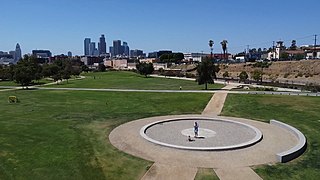
Los Angeles State Historic Park (LASHP) is a California State Park within the Chinatown neighborhood of Los Angeles. Also known as the Cornfield, the former brownfield consists of a long open space between Spring Street and the tracks of the Metro A Line. Located outside the main commercial and residential area in the northeast portion of Chinatown, the area is adjacent and southeast of the Elysian Park neighborhood.
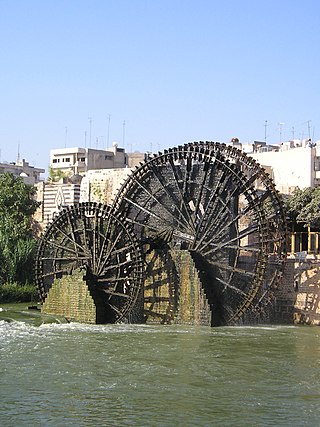
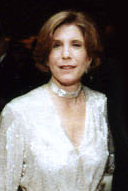
Wallis Huberta Annenberg is an American philanthropist and heiress. Annenberg serves as president and chairwoman of the Board of The Annenberg Foundation, a multibillion-dollar philanthropic organization in the United States.
The Harrison Studio consists of Helen Mayer Harrison (1927–2018) and Newton Harrison (1932–2022) who are among the earliest and the best known social and environmental artists. Often simply referred to as “The Harrisons”, Helen and Newton have produced multimedia work across a vast range of disciplines. They work in collaboration with biologists, ecologists, historians, activists, architects, urban planners and fellow artists to initiate dialogues and create works exploring biodiversity and community development. Helen and Newton Harrison are both Professors Emeriti at University of California, Santa Cruz, and University of California, San Diego. They have had numerous international solo exhibitions and their work is in the collections of many public institutions including the Pompidou Center, the Museum of Modern Art, the San Jose Museum of Art, the Nevada Museum of Art, and the Chicago Museum of Contemporary Art. In 2013 the Harrisons became the first recipients of the Corlis Benefideo Award for Imaginative Cartography. Stanford University Libraries acquired The Helen and Newton Harrison Papers, an extensive archive that documents their life and work with a significant amount of audiovisual material and born-digital files.
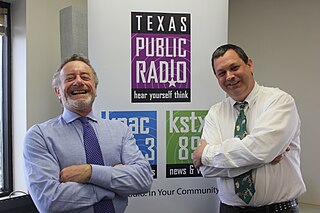
Jarl Mohn is an American venture capital investor, art collector, and philanthropist, who focuses primarily on startups in the Los Angeles area. He served as the president and CEO of NPR from 2014 to 2019 and now serves as its president emeritus.
Charlotte Cotton is a curator of and writer about photography.
Mia Lehrer, born Mía Guttfreund is a Salvadoran American landscape architect. She received a B.A. from Tufts University with a degree in environmental design and a Master of Landscape Architecture degree from Harvard University's Graduate School of Design. Lehrer is one of the first professionals to incorporate both of her degrees to design sustainable landscapes.
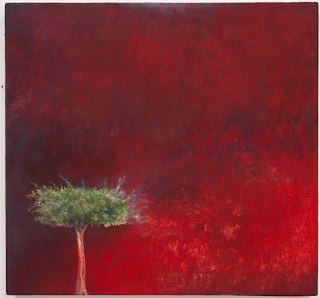
Lucas Joseph Reiner is an American painter, printmaker, photographer and filmmaker. He is most known for painting series that mix elements of representation, narrative, symbolism and abstraction. The work explores subjects such as the collision between organic growth and urban life, the atmospheric effects of fireworks and spiritual themes. His work belongs to the collections of the Los Angeles County Museum of Art, Santa Barbara Museum of Art and Staatliche Graphische Sammlung München, among others, and a monograph of his paintings, drawings and photographs, Los Angeles Trees (2008), was selected as one of the Los Angeles Times "Favorite Books of 2008." That paper's critic David Pagel wrote that his "paintings of trees trimmed to within inches of their lives have the pathos of circus freaks and the stubbornness of survivalists." Reiner has exhibited in the U.S., Germany, Italy and Mexico, at institutions including Los Angeles Municipal Art Gallery and Museo de la Estampa. He is based in Los Angeles and Berlin, and married to Maud Winchester.
Cynthia "Cinny" Clare Kennard is an American business and nonprofit executive, author and former broadcast journalist. She is the executive director of The Annenberg Foundation, based in Los Angeles, and Annenberg PetSpace.
Lisa Diane Wedgeworth is an African-American visual artist, curator, and writer. Her work encompasses abstract painting, video, and performance works. She has been a teaching artist at several Los Angeles-area museums, including the California African American Museum, the Craft and Folk Art Museum, and LACMA. She earned her B.A. in studio art from California State University, Los Angeles, in 2002, and her M.F.A. in Studio Art from the same institution in 2014. In an interview with the magazine Curator in 2018, Wedgeworth cited childhood visits to the Barnsdall Art Park in the 1970s and 80s, and the Candice Bergen-narrated commercials for the Norton Simon Museum, as early influences. She also cites Lezley Saar, daughter of Betye Saar, as well as painter Suzanne Jackson and "outsider/self-taught artists." Wedgeworth's work is in the permanent collection of the California African American Museum.
Carolina Caycedo is a multimedia artist based in Los Angeles.
Lauren Halsey is a contemporary American artist. Halsey uses architecture and installation art to demonstrate the realities of urban neighborhoods like South Central, Los Angeles.
Caitlin Cherry is an African-American painter, sculptor, and educator.
References
- ↑ "Artist Lauren Bon reimagines the L.A. Aqueduct".
- ↑ "NOT A CORNFIELD: TEAM". notacornfield.com. Retrieved 2017-03-29.
- ↑ Raymond, Anthea (2010-07-26). "Artist Lauren Bon's Strawberry Flag Helps Bring Attention to California Veterans". Huffington Post. Retrieved 2017-03-29.
- ↑ "AgH2O: Silver, Water, and Pinhole Camera in a Silo". KCET. 2013-02-28. Retrieved 2017-03-29.
- ↑ "Draft Initial Study/ Mitigated Negative Declaration for Bending the River Back into the City Project" (PDF).[ dead link ]
- ↑ "Metabolic Studio Optics DivisionLiminal Camera: Drought". massmoca.org. 30 September 2016. Retrieved 2017-03-29.
- ↑ "SILVER AND WATER".
- ↑ Rafferty, Rebecca. "ART REVIEW: "Silver and Water"". City Newspaper. Retrieved 2017-03-29.
- ↑ Nevada Museum of Art. "Lauren Bon & The Optics Division Team: Transforming Inert Landscape into Agency | Nevada Museum of Art". www.nevadaart.org. Retrieved 2017-03-29.
- ↑ "Hammer Projects: Lauren Bon and Metabolic Studio - Hammer Museum". The Hammer Museum. Retrieved 2017-03-29.
- ↑ "The Quietus | News | INTERVIEW: Beauty In The Bleak". The Quietus. Retrieved 2017-03-29.
- ↑ "Lauren Bon: Hand Held Objects - SMMoA". SMMoA. Retrieved 2017-03-29.[ permanent dead link ]
- ↑ "Cornfield works find new home". Los Angeles Times. 2007-12-07. ISSN 0458-3035 . Retrieved 2017-03-29.
- ↑ "A Look at Lauren Bon | ArtSlant". ArtSlant. Retrieved 2017-03-29.
- ↑ Nevada Art (2015-03-20), A+E 2014 Intermountain West Lauren Bon and the Harrisons , retrieved 2017-03-29
- ↑ "Lauren Bon". Annenberg Foundation. 2016-03-08. Retrieved 2017-03-29.
- ↑ "Lauren Bon Vs Ranko Bon". Unicourt. Retrieved 7 September 2021.
- ↑ "Lauren Bon". Annenberg Foundation. 2016-03-08. Retrieved 2017-03-19.
- 1 2 "The Boom Interview: Lauren Bon". Boom California. 2015-08-04. Retrieved 2017-03-19.
- ↑ "Bringing 'la noria' back to the LA River". Native Intelligence. Retrieved 2017-03-29.
- ↑ "Yesterday's Water System Back in Los Angeles". KCET. 2012-08-29. Retrieved 2017-03-19.
- ↑ "Yesterday's Water System Back in Los Angeles". KCET. 2012-08-29. Retrieved 2017-03-19.
- ↑ "Bending the River Back Into the City | Metabolic Studio". www.metabolicstudio.org. Retrieved 2017-03-19.
- ↑ Andersen, Lindsey. "L.A. project Strawberry Flag helps veterans through a rough patch". USA Today.
- ↑ "Fallen Fruit Presents EATLACMA" . Retrieved 2021-03-17.
- ↑ "Bldg 209: Garden Folly (Indexical Strawberry Flag) at EATLACMA" . Retrieved 2021-03-17.
- ↑ "Farmlab | Metabolic Studio". www.metabolicstudio.org. Retrieved 2017-03-19.
- ↑ "Not A Cornfield | Curating Cities: A Database Of Eco Public Art". eco-publicart.org. Retrieved 2017-03-19.
- ↑ "Devices of Wonder | VQR Online". www.vqronline.org. Retrieved 2017-03-19.